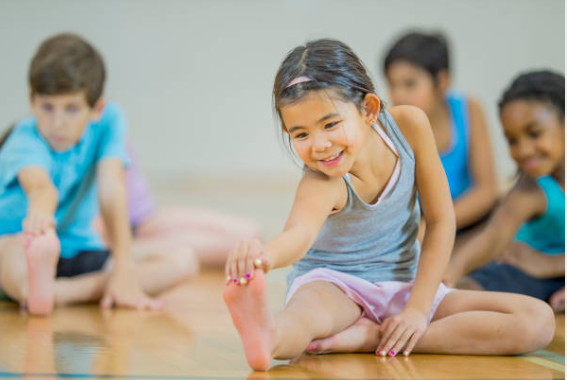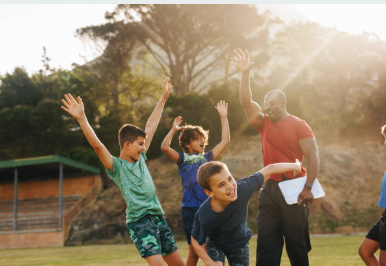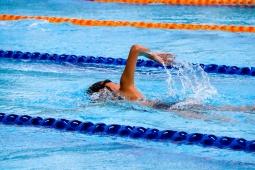Le potentiel inexploité de l’éducation physique

Publié précédemment dans le volume 81, numéro 3
Abstract
Participation in a quality physical education program provides many well-known learning opportunities and benefits for students. However, this paper addresses how participation in quality physical education programs can provide other less well-known benefits which not only impact students, but society as a whole. Specifically, this paper discusses how physical education has the potential to be a beneficial, cost-effective, and physically safe approach to lessen the occurrence of obesity and assist in decreasing mental health issues for students.
In 1983, Dr. Graham Fishburne examined an important query: Is reading more important than physical education? Fishburne (1983) pointed to research studies (e.g., Vanves Project) to illustrate positive results that occurred when schools added physical education time during the day whilst deleting time from the “three Rs.” Although more than 30 years have passed, Fishburne’s important question must still be asked today, and how physical education relates to students’ academic achievement must receive research attention (Bailey et. al, 2009; Chomitz, et al., 2009; Medina, 2008).
The role and status of physical education in today’s Canadian schools varies considerably, and this variation is caused by a multitude of factors (Hickson, Robinson, Berg & Hall, 2012). These include such issues as the perceived lack of value of physical education as an “academic” subject and whether talking to generalist or specialist trained teachers. Therefore, it can be argued that physical education is not regarded as a subject on equal footing with other curricular areas such as language arts, mathematics, science, etc. In fact, there is considerable evidence that physical education has been, and remains, a marginalized subject. For example, it has been noted that physical education classes have been replaced with other subject areas in an effort to increase academic achievement as measured by standardized tests (Coe, Pivarnik, Womack, Reeves, & Malina, 2006).
With such an array of educational research suggesting that added physical education time and less time for the “three Rs” does not negatively impact academic achievement (Castelli, Hillman, Buck, & Erwin, 2007; Sallis, McKenzie, Kolody, Lewis, Marshall, & Rosengard, 1999; Shephard, 1997; Taras, 2005; Singh, Uijtdewilligen, Twisk, van Mechelen, & Chinapaw, 2012), it seems likely that the messages being sent to educational decision makers (e.g., policy makers, administrators, teachers) are not being heard, understood or accepted. Therefore, the authors of this paper intend to demonstrate that physical education is a necessity for every student in Canada and why it should become more thoroughly understood, accepted and implemented by educational decision makers.
Societal issues
Participation in a quality physical education program provides many important learning opportunities and benefits for students. Among these, benefits such as the development and acquisition of motor, leadership and cooperative skills are most likely well known. However, quality physical education experiences can provide other benefits that are less well known and discussed; benefits that not only impact students but also society as a whole. For example, two major challenges that are presently impacting society are obesity and mental health issues, such as depression and anxiety. Physical education may be the perfect way to combat these issues. School-based physical education programming has the potential to be a beneficial, cost-effective, developmentally appropriate, and physically safe approach to lessen the occurrence of obesity and assist in decreasing mental health issues for students (Hales & Lauzon, 2013; Heart and Stroke Foundation, 2015).

Rising rates of obesity
The obesity epidemic is on the rise. Since the early 1980s, rates of obesity have more than doubled worldwide (Hales & Lauzon, 2013) and Active Healthy Kids Canada (2007) stated that one quarter of Canadians aged 2 to 17 were identified as overweight or obese. Since 1978, obesity has almost tripled in children and youth (Butler-Jones, 2008). Butler-Jones (2008) further contended that due to the current levels of physical inactivity and poor nutritional practices, obesity rates will most likely continue to increase in Canada. According to Active Healthy Kids Canada (2014), Canada lags behind several other countries in active behaviours. Hence, underlying postulations concerning research on obesity are that people are getting larger in epidemic proportions worldwide (Fitzpatrick, 2011; Hales & Lauzon, 2013; World Health Organization, 2010). Levitan and Davis (2010) contended that obesity is associated with several medical complications (e.g., diabetes, cardiovascular disease) and negative mental health outcomes that affect quality of life. The obesity epidemic holds profound negative implications at the personal, familial and societal levels (Levitan & Davis, 2010), and is caused primarily from over-consumption of food and sedentary lifestyles (Hales & Lauzon, 2013; Levitan & Davis, 2010).
With obesity threatening the health of our society (Spence, Carson, Casey, & Boule, 2011), students have become a particular focus (Gard & Wright, 2005). In fact, according to Hales and Lauzon (2013), several million children aged 5 years and younger were identified as being overweight. Further, in Canada, one in ten children is classified as clinically obese (Canadian Obesity Network, 2015) and Gard and Wright (2005) asserted that today’s children are described by experts as not only larger than previous generations, but also lacking in self-discipline, less active, less athletically skilled and increasingly disinterested in physical activity. These factors could lead to a likelihood of making life decisions that involve sedentary behaviour and physical inactivity that can result in negative health issues.
The emotional connection
Over the years, researchers have identified physical activity as a protector from obesity (Hales & Lauzon, 2013; Heart and Stroke Foundation, 2015). However, recent literature has begun to point into a new direction whilst striving to deal with the issue of overeating. For example, Hedley, Ogden, Johnson, Carroll, Curtin, and Flegal, (2004) contended that an emotional relationship with food (e.g., overeating) from an early age helps develop long-term consequences (e.g., obesity) which result in significant personal, familial and societal costs.
In support of this, substantial research findings indicate that emotional regulation plays a critical role in food consumption (Gard & Wright, 2005). Several negative emotions (e.g., frustration, aggravation, fatigue) can instigate a bout of overeating. Of particular concern is the fact that high-caloric, highly palatable foods, which are the most problematic in terms of weight gain and obesity, also have the strongest effect on alleviating negative mood states (e.g., depression, anxiety) (Gard & Wright, 2005). Moreover, depression and anxiety are often the primary reasons for overeating (Levitan & Davis, 2010). This can result in individuals self-medicating their emotions (e.g., decreasing activity in the brain’s stress-response network) with food during depressive and anxious times (Brown Schiraldi, & Wrobleski, 2009; Levitan & Davis, 2010; Perpina, Cebolla, Botella, Lurbe, & Torro, 2011). Unfortunately, there is a cost to this behavioural coping strategy, including increased risk of developing abdominal obesity, type 2 diabetes, cardiovascular disease and stroke.
Addressing the obesity epidemic may well require a greater focus on emotional processes if significant progress is to be made (Levitan & Davis, 2010). Given that obesity is becoming increasingly common in students, developing a broader understanding about the earliest origins of emotional eating and constructing intervention strategies must become a priority (Raj & Kumar, 2010). As stated previously in this section, mental health issues (e.g., depression, anxiety) are strong contributors to emotional eating and must be addressed if the aim is to reverse the obesity epidemic (Brown Schiraldi, & Wrobleski, 2009; Hales & Lauzon, 2013; Levitan & Davis, 2010; Perpina, Cebolla, Botella, Lurbe, & Torro, 2011). Future research in this area may greatly improve our understanding of the basic vulnerabilities contributing to obesity.
Importance of serotonin levels and physical activity
In the research concerning how the brain functions during stressful events, it is critical to recognize the importance of serotonin levels in the brain. The human body creates serotonin naturally; researchers believe that it is responsible for maintaining mood balance. In support of this, Greenwood and Fleshner (2011) identified the importance of serotonin levels as a necessity for individuals to deal with stressful situations in a positive manner and to lessen levels of mental health issues. One of the most common mental health issues today is depression; a diagnosis that's on the rise in our society. Studies suggest that as many as 14 to 25% of Canadian children and youth experience significant mental health issues such as depression (Canadian Institute for Health Information, 2009; Waddell, Shepherd, Chen, & Boyle, 2013). In fact, by the year 2020, depression is predicted to become the second highest lifetime burden of disease, exceeded only by heart disease (Greenwood & Fleshner, 2011).
Physical activity has been found to reduce the occurrence and severity of mental health issues (Greenwood & Fleshner, 2011; Hales & Lauzon, 2013). Armed with this information, school teachers and administrators can begin to understand the positive impact that physical activity can have on students' mental health.
The need for increased levels of serotonin is critical for the resistance effect with respect to mental health issues (Greenwood & Fleshner, 2011). However, some methods of increasing serotonin levels are more beneficial than others. For example, overeating and physical activity are both capable of increasing serotonin levels and can, thereby, potentially lessen mental health issues. However, given our understanding of the negative impact overeating has on the human body, it is important that education officials focus on quality physical education programming to help defend against mental health issues.
It is time for researchers and educationalists to undertake serious investigation of how to fuse the critical information that has been amassed in these areas. Obesity and mental health issues need to be understood in relation to the latest findings in brain research and what we have learned about the positive impacts of quality physical education programming. It should be alarming to all education stakeholders that according to Active Health Kids Canada (2007), fewer than 50% of Canadian children and youth are identified as being physically active enough to ensure healthy growth and development. With an understanding of how physical activity protects against mental health issues, we must consider how this impacts the wellbeing of Canadian children and youth.
Physical education still marginalized
Quality physical education programs enhance physical activity opportunities and benefit student health (Fishburne & Hickson, 2005). As a curricular subject area, it helps students to develop the knowledge, skills and attitudes necessary for participating in active, healthy living. As such, not only is physical education an integral component of the total school experience but also a contributor to a number of student benefits (UNESCO, 2014). When receiving quality physical education experiences, students develop proficiency in fundamental movement skills required to become successful in large group games, individual activities, and/or dance-type activities (Physical and Health Education Canada, 2015a). With these fundamental movement skills, levels of self-efficacy have been found to increase and individuals may well become more equipped to develop active, healthy lifestyles (Lubans, Morgan, Cliff, Barnett, & Okely, 2010). As well, physical education can promote physical fitness, movement knowledge and physical competence (Fishburne, 2005, Fishburne & Hickson, 2005). Through appropriate learning activities and experiences, physical education can contribute to other curricular goals including: self-direction; cooperative behavior; goal-setting; creativity; and intellectual growth. With all of these benefits, alongside its ability to combat the obesity epidemic and mental health issues (Hales & Lauzon, 2013), one may ask why physical education remains a marginalized subject area.

Schools missing recommended physical activity targets
The literature clearly points to the necessity of physical activity for students and the need for establishing quality physical education experiences (Fishburne, 2005; Palmer & Bycura, 2014; Taras, 2005). Hence, it is noteworthy to point out that although there is such evidence in support of physical activity and physical education, the amount of instructional time devoted to this subject area varies greatly. According to Active Healthy Kids Canada (2014), 82% of students’ parents believe that schools should place more importance of the implementation of quality physical education programming. In Canada, for example, all elementary school students (ages 5-12) and junior high school students (ages 12-15) are required to receive physical education instruction (Physical and Health Education Canada, 2015b). Yet each Canadian province/territory has set different instructional time allocations (as guidelines or requirements) for physical education within all of the grade levels (Hickson, Robinson, Berg & Hall, 2012). As an example, for the elementary school years, the amount of time ranges from 75 to 165 minutes per week across the country. This is not a uniquely Canadian issue, though. The U.S. Centers for Disease Control and Prevention (2006) stated that although most U.S. schools required physical education within their overall curriculum, in reality the vast majority of students do not receive the nationally recommended amount of physical education. This is quite surprising when there is such clear evidence that supports adding physical education time in the school’s timetable. For example:
-
adding time for physical education does not impact academic achievement negatively (Sallis et al., 1999; Trudeau & Shephard, 2008)
-
physical activity increases blood flow to the brain (Taras, 2005) and helps raise serotonin levels to help lower mental health issues (e.g., depression) (Greenwood & Fleshner, 2011)
-
physical education plays an integral role in developing the whole child (Physical and Health Education Canada, 2015c; National Association for Sport and Physical Education, 2011)
-
physical education can help improve behaviors and on-task attention (Kubesch, et al., 2009; Medina, 2008)
The school setting provides a unique opportunity in which to create positive learning experiences that can foster healthy student habits. As such, we contend that schools should strive to design experiences that benefit students in a holistic manner and truly support today’s major societal issues such as obesity and mental health.
Need for future thought and research
This paper was written as an effort to point to some societal issues that are directly linked to the brain in order to claim that physical education may be one of the most effective problem solvers. Future thoughts, ideas and research could include questions such as:
-
How can a quality physical education program affect student thoughts towards overeating?
-
For students who have been identified as being depressed, what is the duration of time required to lessen issue through quality learning in physical education?
-
How can new understanding of the “whole body” assist physical education teachers in the supporting of students?
Conclusion
Education decision-makers are not acknowledging the full potential of physical education as a curricular area. Quality physical education programs have the ability to make such a positive impact on students. Research suggests that if teachers provide quality physical education programming, their students are more likely to become truly physically educated (Hickson, 2003). This, in turn, may help establish healthy, active lives and avoid mental health issues.
Communication between researchers, educational policy makers and school teachers must be at the forefront in order for students to be provided with the most effective learning environment possible. As of today, there seems to be minimal, if any, communication between these groups regarding the health and wellbeing of children. Canada has the opportunity to be a leader when it comes to providing children and youth with quality physical education programming that will aid in positive learning environments and healthy development. We need to begin and continue this conversation for now, and for future generations.
References
Active Healthy Kids Canada. (2007). Canada’s report card on physical activity for children and youth. Retrieved from: http://dvqdas9jty7g6.cloudfront.net/archivedreportcards/full-english-report-card-2007.pdf
Active Healthy Kids Canada. (2014). Report card on physical activity for children and youth. Retrieved from: http://dvqdas9jty7g6.cloudfront.net/reportcard2014/AHKC_2014_ReportCard_ENG.pdf
Bailey, R., Armour, K. , Kirk, D. , Jess, M. , Pickup, I. , Sandford, R. , Pearce, G. and BERA Physical Education and Sport Pedagogy Special Interest Group, . (2009). The educational benefits claimed for physical education and school sport: An academic review. Research Papers in Education, 24(1), 1-27.
Brown, S.L., Schiraldi, G.R., Wrobleski, P.P. (2009). Association of eating behaviors and obesity with psychological and familial influences. American Journal of Health Education, 40(2), 80-89. DOI: 10.1080/19325037.2009.10599082
Butler-Jones, D. (2008). Report on the state of public health in Canada. Retrieved from: http://www.phac-aspc.gc.ca/cphorsphc-respcacsp/2008/fr-rc/pdf/CPHO-Report-e.pdf’
Canadian Institute for Health Information (2009). Children’s mental health in Canada: Preventing disorders and promoting population health. Ottawa, ON.
Canadian Obesity Network. (2015). Obesity in Canada. Retrieved from: http://www.obesitynetwork.ca/obesity-in-canada
Castelli, D.M., Hillman, C.H, Buck, S.M., & Erwin, H.E. (2007). Physical fitness and academic achievement in third- and fifth-grade students. Journal of Sport & Exercise Psychology, 29, 239-252.
Chomitz, V.R., Slining, M.M., McGowan, R.J., Mitchell, S.E., Dawson, G.F. & Hacker, K.A. (2009), Is there a relationship between physical fitness and academic achievement?
Positive results from public school children in the northeastern United States. Journal of School Health, 79, 30–37. DOI: 10.1111/j.1746-1561.2008.00371.x
Coe, D.P., Pivarnik, J.M., Womack, C.J., Reeves, M.J., & Malina, R.M. (2006). Effects of physical education and activity levels on academic achievement in children. Medicine & Science in Sports & Exercise, 38 (8), 1515-1519. DOI: 10.1249/01.mss.0000227537.13175.1b
Fishburne, G.J. (1983). Is reading more important than physical education? Elements: A Journal for Elementary Education, 15(1), 3-5.
Fishburne, G.J. (2005). Developmentally appropriate physical education for children and youth. University of Alberta: Ripon Publishing.
Fishburne, G.J. & Hickson, C. (2005). What is the Relationship between Physical Education and Physical Activity? National Major Position paper for Canadian Association for Health, Physical Education, Recreation and Dance. Ottawa: CAHPERD.
Fitzpatrick, K. (2011). Obesity, health, and physical education: A bourdieuean perspective. Policy Futures in Education, 9(3), 353-365.
Gard, M., & Wright, J. (2005). The obesity epidemic: Science, morality and ideology. New York: Routledge.
Greenwood, B.N., & Fleshner, M. (2011). Exercise, stress resistance, and central serotonergic systems. Exercise and Sport Sciences Reviews, 39(3), 140-149.
Hales, D. & Lauzon, L. (2013). An invitation to health. 3rd Ed. University of Victoria: Nelson Education.
Heart and Stroke Foundation. (2015). Position Statement: Schools and Physical Activity.Retrieved from: http://www.heartandstroke.com/site/c.ikIQLcMWJtE/b.2796497/k.F922/Heart_Disease_Stroke_and_Healthy_Living.htm
Hedley, A.A., Ogden, C.L., Johnson, C.L., Carroll, M.D., Curtin L.R., & Flegal, K.M. (2004). Prevalence of overweight and obesity among US children, adolescents, and adults, 1999–2002. Journal of the American Medical Association, 291(23), 2847–2850.
Hickson, C. (2003). Putting education back into P.E. International Journal of Learning, 10.
Hickson, C., Robinson, D., Berg, S. & Hall, N. (2012). Active in the north: School and community physical activity programming in Canada. International Journal of Physical Education, 2(12), 16-30.
Kubesch, S., Walk, L., Spitzer, M., Kammer, T., Lainburg, A., Heim, R., & Hille, K. (2009). A 30-minute physical education program improves students' executive attention. Mind, Brain, And Education, 3(4), 235-242.
Levitan R.D., & Davis, C. (2010). Emotions and eating behaviour: Implications for the current obesity epidemic. University of Toronto Quarterly, 70(2), 783-799. DOI: 10.3138/utq.79.2.783
Lubans, D.R., Morgan, P.J., Cliff, D.P., Barnett, L.M., & Okely, A.D. (2010). Fundamental movement skills in children and adolescents: Review of associated health benefits. Sports Med, 40(12), 1019-1035.
Medina, J. (2008). Brain Rules. Seattle, WA: Pear Press.
National Association for Sport and Physical Education. (2011). Physical education is critical to educating the whole child: A position statement. Retrieved from: http://www.shapeamerica.org/advocacy/positionstatements/pe/loader.cfm?csModule=security/getfile&pageid=4650
Palmer, S. & Bycura, D. (2014). Beyond the gym: Increasing outside of school physical activity through physical education. Journal of Physical Education, Recreation and Dance, 85(1), 28-35.
Perpina, C., Cebolla, A., Botella, C., Lrube, E., & Torro, M. (2011). Emotional eating scale for children and adolescents: Psychometric characterisitcs in a spanish sample. Journal of Clinical Child & Adolescent Psychology, 40(3), 424-433.
Physical and Health Education Canada. (2015a). Physical Education in School. Retrieved from: http://www.phecanada.ca/physical-education-school
Physical and Health Education Canada. (2015b). Across Canada. Retrieved from: http://www.phecanada.ca/advocacy/across-canada
Physical and Health Education Canada. (2015c). Physical Literacy. Retrieved from: http://www.phecanada.ca/programs/physical-literacy/what-physical-literacy
Raj, M. & Kumar, K. (2010). Obesity in children & adolescents. Indian Journal of Medical Research, 132(5), 598-607.
Sallis, J.F., McKenzie, T.L., Kolody, B., Lewis, M., Marshall, S., & Rosengard, P.
(1999). Effects of health-related physical education on academic achievement: Project SPARK. Research Quarterly for Exercise and Sport, 70(2), 127-134.
Shephard R.J. (1997). Curricular physical activity and academic performance. Pediatric Exercise Science, 9, 113-126.
Singh, A., Uijtdewilligen, L., Twisk, J.W., van Mechelen, W., & Chinapaw, M.J. (2012).Physical activity and performance at school: A systematic review of the literature including a methodological quality assessment. Archives of Pediatrics & Adolescent Medicine, 166(1), 49-55. DOI: 10.1001/archpediatrics.2011.716.
Spence, J.C., Carson, V., Casey, L., & Boule, MN. (2011). Examining behavioural
Susceptibility to obesity among Canadian pre-school children: The role of eating
behaviours. International Journal of Pediatric Obesity, 6, 501-507.
Taras, H. (2005). Physical activity and student performance at school. Journal of School Health, 75(6), 214-218.
Trudeau, F., & Shephard, R.J. (2008). Physical education, school physical activity, school sports and academic performance. International Journal of Behavioral Nutrition and Physical Activity, 5(10). DIO: 10.1186/1479-5868-5-10
UNESCO. (2014). Quality physical education policy project. Retrieved
from: http://www.unesco.org/new/en/social-and-human-sciences/themes/physical-education-and-sport/quality-physical-education/policy-project/
U.S. Centers for Disease Control and Prevention. (2006). SHPPS: School health policies and practices study. Retrieved from: http://www.cdc.gov/healthyyouth/shpps
Waddell, C., Shepherd, C., Chen, A., & Boyle, M. (2013). Creating comprehensive children’s mental health indicators for British Columbia. Canadian Journal of Community Mental Health, 32(1), 9-27.
World Health Organization (WHO) (2010). Childhood overweight and obesity. Retrieved from: www.who.int/dietphysicalactivity/childhood/en/index.html.









